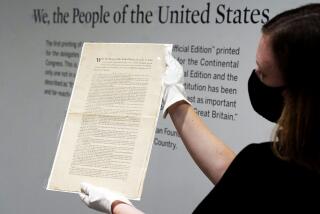A Tribute to a Moving Declaration
- Share via
A fter the Continental Congress signed the Declaration of Independence on July 4, 1776, the manuscript of the document was sent to a Philadelphia printer, who typeset it and created approximately 200 “broadsides” of the text.
Only 25 of these Dunlap “broadsides” still exist. Last year, producer Norman Lear (“All in the Family”) his wife, Lyn, and David and Storey Hayden bought one of the surviving original prints through Sotheby’s for $8 million. This document is touring the country as the centerpiece of the Declaration of Independence Road Trip, which makes its first stop Friday at the Ronald Reagan Presidential Library. The exhibit, through Jan. 20, will also feature one of nine existing copies of the Dunlap & Claypoole United States Constitution from September 1787 , Benjamin Franklin’s original draft of the Articles of Confederation, a swatch from a silk reception dress of Martha Washington, an original broadside “invitation” to the Boston Tea Party and Paul Revere’s hand-colored engraving of the Boston Massacre.
Lear, 79, talked last week about the document and the exhibit.
Question: Do you remember the first time you learned about the Declaration of Independence?
Answer: I think hearing it excerpted out of context caught [my attention] and then I went to the source.
Q: How did the Declaration of Independence Road Trip come about? A: I read someplace [the broadside of the Declaration] was going to be offered on the Internet by Sotheby’s. It was [on display] at Sotheby’s on Wilshire Boulevard and an associate and I went over there at lunch and looked at it and filled up [with emotion]. I didn’t go thinking I was going to buy it. That happened when I was looking at it and relating to it a bit emotionally and thought: “The people’s document. Wouldn’t this be wonderful if this was among the people?” By the time I got back to the office, the basic sketch of what we were doing was in my head. After I had gotten it and it was announced, then [many presidential] libraries came to us and wished to have it. So things developed from there.
Q: What type of condition was the copy in when you bought it?
A: It was in fair shape. We have had [preservation work] done on it twice. I think the document itself has proved its durability in more ways than one. So it is protected [during the exhibitions] as well as we can protect it, but it is going to be out there.
Q: Are you surprised at the tremendous interest around the country to see the copy?
A: [The Founding Fathers] were prepared to give up ... their lives [to be free from England]. We, in order to participate [in our government], are blessed with simply having to participate. We don’t have to give up anything.
When all is said and done, what I hope for the Declaration when it moves among people is to help people understand that in every generation, all of us wish change. We wish our government, in different ways, was different, but we don’t have to do that much to see change.
We don’t have to give up our lives and our fortunes. This document wants to help you believe you matter.
Q: Do you see this tour lasting for several years?
A: Oh, yeah. By July 2003 we will have had the experience in state fairs [and] other venues, and be able, on July 4, 2004, to do some gigantic patriotic revival meeting that will then travel--that particular show--certainly through the election of 2004. It will be a great kick if we could have some way of perceiving if around election time 2004 [the tour] has had some effect [in getting people interested in voting].
*
“Freedom’s Journey: The Declaration of Independence and Beyond” runs Sept. 14 through Jan. 20, 2002 at the Ronald Reagan Presidential Library, 40 Presidential Drive, Simi Valley. The museum is open daily 10 a.m.-5 p.m. Admission is $5; $3 for seniors: free for children 15 and under. Call (800) 410-8354.
More to Read
The biggest entertainment stories
Get our big stories about Hollywood, film, television, music, arts, culture and more right in your inbox as soon as they publish.
You may occasionally receive promotional content from the Los Angeles Times.










